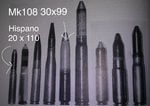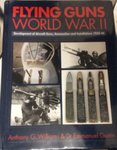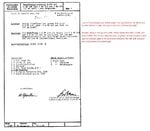David Fred
Airman
- 46
- Feb 7, 2018
besides using wikipedia, what was the difference in weight between a Mk.5 Hispano and M2 Browning?
Here's the comparison between the 20mm Hispano and the Mk108 30 x 99.Note that only 1/3 of the 30mm is propellant. Muzzle velocity is only 550 m/s, which means a 5 meter drop at 550 meters. Plus, the plane had 100 rounds per gun firvthe bottom two, and 80 founds per gun for the top two.
This is an interesting (if crappy) cannon. In order to increase rate of fire from about 410 rpm to 600, instead of mounting the recoil spring around the barrel like a Bofors, they put it behind the bolt. To prevent a release of explosive gases in the fuselage, it had a very short barrel, (44cm) hence the lower muzzle velocity.





